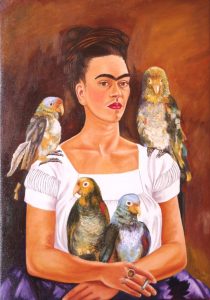I’m still muy ocupado, carefully and thoughtfully packing for my move next week – but taking things poco a poco, as we strive to do here in Mexico. (See last week’s post for the fuller story.) So I’ve asked my new friend Frida to come to my rescue and provide this week’s WOW post.
To be totally honest (is there any other way to be?), Frida is a fictitious friend; and it’s just the fictional story of my efforts to befriend her that will serve as this week’s post.
This story, “Frida and Me,” as you may have noted as a post script in my previous WOW post, was recently named a finalist in a flash-fiction contest by The Ekphrastic Review, an online journal edited and founded by Canadian writer and artist Lorette C. Luzajic, devoted entirely to writing inspired by visual art. For more about this marvelous journal, go to: https://www.ekphrastic.net/about.html
If you didn’t have the chance to click on the link I gave last week to get to the contest’s finalists, here is Frida Khalo’s self-portrait, “Me and My Parrots,” and my ekphrastic response to it, in full:

Frida and Me
Your face, Frida, is everywhere around here. On just one stroll through the local mercado de artesanías on a sweltering Mexican afternoon recently, I saw your image on jewelry, jewelry boxes, face masks, key chains, change purses, back packs, T-shirts, blouses, swim suits, shopping bags, notebooks, fridge magnets, postcards, and of course in picture frames.
Your popularity appears to rival that of the Virgin of Guadalupe, Mexico’s beloved patron saint. I fear, though, you’ve become a cliché, and I doubt you’d like that much.
What is it about you, Frida, that has captivated this country and has driven manufacturers to make so many souvenirs with your image painted on them for tourists to take back to their respective countries as mementos? Might you be the face of female Mexico?
There’s you smiling, you frowning; you with flowers in your hair, with monkeys on your shoulder; wearing an embroidered huipil in vivid colors like a young girl, wearing a rebozo wrapped around your torso like an old woman. There’s your trademark unibrow like a tarp over your eyes. In some of these souvenirs you look vulnerable, as if sleeping; in others you stare at the viewer like a dare. Are all of these self-portraits? Did you ever tire of painting yourself?
What were you really like, I sometimes wonder. If I had lived in your time and place, could we have become friends? Honestly, I doubt it. I study these images of you in the many small stalls at the mercado, and I see little that might connect us, other than our shared gender.
But this portrait, this one with the parrots, is unlike all the others I’ve seen of you. It is mesmerizing, and flooding me with memories. At last, I can see we have one more thing in common, querida Frida: a love of parrots.
I had a Senegal parrot once in Africa who lived in a large, globe-shaped wicker cage tucked in the crook of the central branches of a young mango tree directly in front of my study window in the front of my small, cement-block home in Mali. I named him Irwin, after the American missionaries who bequeathed him to me when they left the country. If it’s possible to love a bird the same way we women are capable of loving a puppy or a kitten – delightedly — that’s the way I loved Irwin. Somehow, Frida, I think you would understand.
Irwin, with his gray, characteristic curved beak and yellow-rimmed, beadlike eyes, was the same pale green color, tapered, oblong shape, and roughly eight-inch length as a young mango leaf. So he was perfectly camouflaged in the mango tree. In fact, to make him happy, I tied together several of the branches of the nearby mango trees to his tree, so he could stroll along this aerial walkway when I let him out of his cage during the day, in lieu of flying.
The missionaries had — cruelly, I thought — clipped his wings to prevent him from flying away when he lived with them. But whatever bitterness and resentment he had harbored toward them for doing this, he promptly forgot soon after coming to live with me. His daily strolls – more like military struts – from mango tree to mango tree seemed to delight him. He whistled, chortled, laughed and sang what sounded like freedom songs as he swaggered among the high branches. Some of the words to these distinctive, squawky songs seemed to be, “Look at me! I am beautiful! I am FREE! I’m no longer in a cage! I can do as I please all day!”
Ah, is that it, Frida? Did your parrots sing freedom songs to you too? I know that life had cruelly clipped you, as it has me, albeit in different ways. Could this be our common bond: that you and I loved our parrots so deeply because they knew the words to our songs?
~ ~ ~ ~ ~ ~ ~ ~
Please be sure to read the other finalists’ flash-fiction pieces at: https://www.ekphrastic.net/ekphrastic-journal/ekphrastic-bird-watching-contest-flash-fiction-finalists/
And to read a brilliant essay by Peter Schjelhahl in a 2007 issue of the New Yorker, which was pointed out to me well after I wrote and submitted my “Frida and Me” piece, go to:
